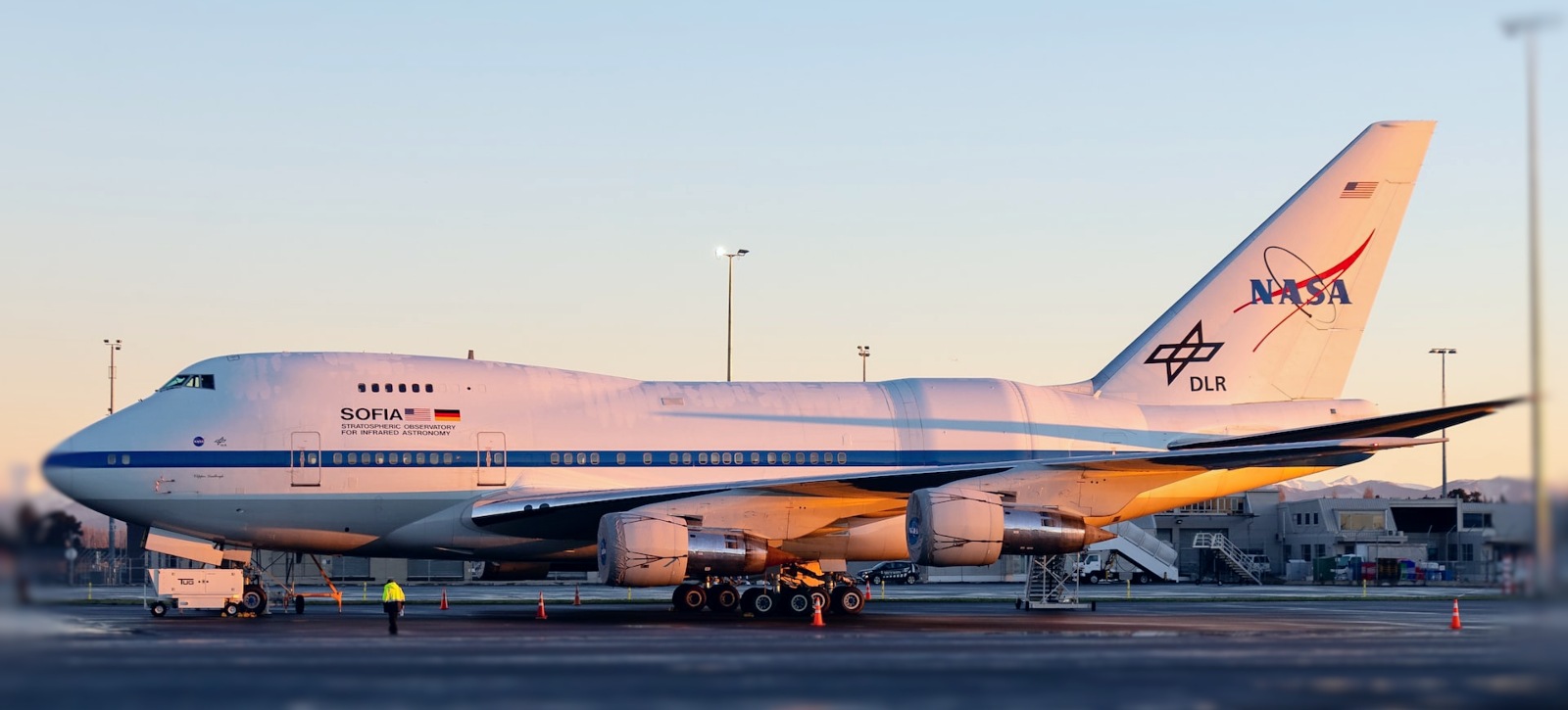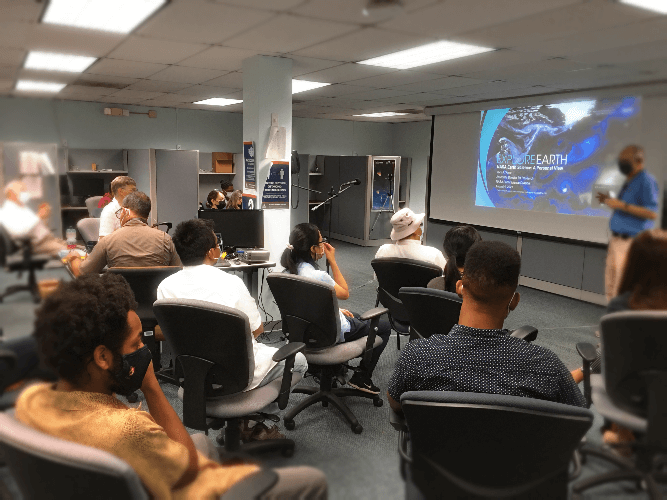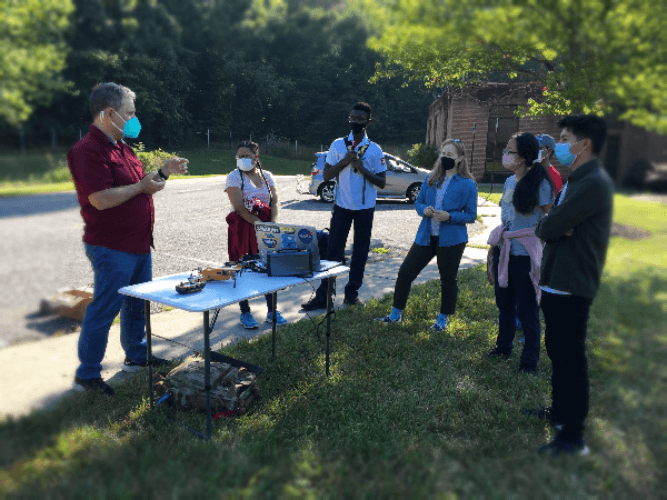Howard NASA Science Activation Program
Welcome to Howard's SaSa Program
The U.S. needs a diverse and highly skilled STEM workforce to build our climate resilience and mitigate against weather-related disasters. Howard's SaSa internship program draws on NASA SMD's (Science Mission Directorate's) experts, space-based observatories, and unique aircraft assets and the strong research expertise of Howard's interdisciplinary Atmospheric Sciences program to create a rewarding learning experience.
As part of the eight-week paid summer internship experience, students learn from NASA scientists and Howard faculty mentors about a range of topics such as basic remote sensing principles, atmospheric and environmental sciences, and data analysis. Students help operate aircraft instruments to sample atmospheric gases and/or image land and water surfaces. Participants receive a stipend and travel/housing expenses are covered.
The internship program builds on the work of Howard's NOAA Cooperative Science Center in Atmospheric Sciences and Meteorology (NCAS-M) to prepare students from traditionally underrepresented groups for rewarding careers in STEM. Students gain hands-on research experience, including flying onboard the NASA P-3 research aircraft to collect land, ocean, and atmospheric data and guidance to pursue graduate careers in STEM.
NASA Science Mission Directorate
The NASA Science Mission Directorate builds on NASA's science vision to "use the vantage point of space to achieve with the science community and our partners a deep scientific understanding of our planet, other planets and solar system bodies, the interplanetary environment, the Sun...and the universe beyond" and "partner with others to substantially improve science, technology, engineering and mathematics (STEM) education nationwide."
Hands-On Research Experience
During SaSa Airborne summer deployments, the NASA P3-B Aircraft will fly over the Howard University Beltsville Campus and other ground-based observation sites to acquire correlative data that can be used together with satellite data to study various atmospheric and environmental processes across the Middle Atlantic region. SaSa interns will be fully involved in the planning and implementation of the scientific research experiments along with the participating scientists from Howard University, partner institutions, and NASA Centers.
Program Goals
Program Goals
- To create a student geoscience learning ecosystem to enable effective student engagement with NASA scientists, engineers, academic advisors, peers, and local communities
- To provide students with new skills to work with NASA science equipment and real data from field/airborne campaigns and satellites
- To provide students with problem-solving skills in instrument development, operation, and scientific measurements, and to equip students with mathematical tools and methods to analyze field data
- To provide research, mentoring, and networking opportunities for early-career undergraduates to address the shortage of individuals from historically underrepresented groups graduating with STEM degrees from Minority Serving Institutions (MSIs)
- To prepare students to enter STEM graduate programs as well as the research workforce at NASA and similar organizations
Program Benefits
Program Benefits
- 8-week program at two NASA centers and six Minority Serving Institutions (MSIs), including Howard University
- Receive a competitive stipend, with travel and housing expenses covered
- Gain hands-on research experience with the guidance of faculty and NASA research mentors
- Fly onboard NASA research aircraft
- Gain practical training in scientific research, data collection, and experimentation
- Opportunity to present at national Geoscience conferences
- Access to ongoing professional development activities, workshops, mentoring, and the SaSa community network
Who Can Apply
Who is Eligible to Apply?
Howard University selection criteria for students:
- Enrolled full-time at Howard University
- First- or second-year undergraduate student
- Good academic standing with a GPA of 3.0 or greater
- Interest in pursuing a STEM-related degree and career
- Interest in the Earth, Ocean, or Atmospheric Sciences
- U.S. citizen or non-citizen national
How to Apply
How to Apply
Apply online at https://www.nasa.gov/content/sasa.
The application period is now closed and will open in the fall.
The applicant must submit the entire application package, which should include:
- Personal statement, statement of interest;
- 2 letters of recommendation; and
- Official transcript(s)
Research Mentors
Our Research Mentors
Our research community and mentors include faculty, NASA Subject Matter Experts, students affiliated with the GLE, and graduate mentors. HUBC-affiliated academic and research faculty have a broad range of expertise encompassing observations and modeling of land-atmosphere interaction processes within the planetary boundary layer (PBL). They also have a strong facility with upper air atmospheric profiling using lidars and regular launches of radiosondes and specialized sensors on weather balloons. These scientists conduct intensive measurements at the site and participate in various national and international research programs as well as field campaigns. Examples of field campaigns that HUBC personnel have actively participated in over the last several years include:
- The NASA/NOAA Fire Influence on Regional to Global Environments and Air Quality (FIREX-AQ) joint field campaign (2019)
- The NASA Ozone Water-Land Environmental Transition Study (OWLETS) field campaign (2018)
- Deriving Information on Surface conditions from Column and Vertically Resolved Observations Relevant to Air Quality (DISCOVER-AQ) field campaign (2011)
- NASA Water Vapor Variability - Satellite/Sondes (WAVES) field campaign (2006)
- HUBC scientists participate in annual AERosols and Ocean Science Expeditions (AEROSE) aboard the NOAA Ron Brown ship to characterize Saharan dust transport across the Atlantic Ocean, using instrumented, shipboard-adapted research trailer.
Meet the SaSa Class of 2022
Angelica Stewart
Major: Computer Science
"The Earth’s resources are all we have and understanding the composition on a molecular level can further advance scientific insights to help the proliferation of the tech world. [SaSa] is an opportunity to grow in a practical research environment. The SaSa program will provide practical experience to be prepared for PhD programs… I am looking forward to gaining hands-on research experience, learning more about geoscience and connecting the subject to computer science.”
Kennedi White
Major: Mechanical Engineering
Minors: Physics, Math, and English
"I've always been infatuated working with NASA and being a part of the driving force behind space, Earth, and atmospheric exploration. Coupling this with my childhood interest in marine science [and] exploration, and the relationship with engineering, applying to SaSa became the culmination of all of my past and present interests…Over the summer I would like to build a better understanding [of] how to collect data and interpret it to make concrete conclusions on how the Earth is doing.”
Atmospheric Sciences at Howard
Howard University’s Atmospheric Science program is a degree-granting interdisciplinary program established by the Howard University Board of Trustees in 1997. The program is dedicated to preparing students, especially those from traditionally underrepresented groups, for leadership careers in atmospheric science and related fields. The program leads a 13-member consortium of Universities in the NOAA Cooperative Science Center in Atmospheric Sciences and Meteorology (NCAS-M), which trains students from underrepresented minority communities to high-quality standards in various STEM fields aligned with the portfolio of NOAA and other national and state agencies. The program has strong academic and research expertise in diverse areas of Earth System and Environmental Sciences, particularly in Atmospheric Sciences and related fields.
Howard’s Beltsville Campus
The University runs a world-class research center in Beltsville, MD, dedicated to studying climate, air quality, and weather, and their impacts on the evolving urban-rural interface. The center is equipped with a wide variety of instrumentation and research assets, including a C-band Doppler radar, a 31-meter flux tower, Lidars, Ceilometers, comprehensive surface radiation measurement sensors, surface air quality instrumentation, and extensive upper air measurement capabilities including balloon launches of radiosondes, ozone sondes, and the cryogenic frost point hygrometer (CFH). The Center is located close to NASA Goddard Space Flight Center, NOAA Center for Weather and Climate Prediction, and other notable national, state, and local agencies and institutions. One of the major air quality monitoring stations of the Maryland Department of the Environment is located at HUBC.
Frequently Asked Questions
How do I apply for SaSa?
Apply online at https://www.nasa.gov/content/sasa.
The application period is now closed and will open in the fall.
The applicant must submit the entire application package, including personal statement, statement of interest, 2 letters of recommendation, and official transcript(s), by the January 31 deadline for full consideration.
Do you accept unofficial transcripts?
Yes, unofficial transcripts are accepted if they are downloaded from your university website. Scanned copies of official transcripts are also acceptable; please upload your scanned transcripts as a PDF to your application. Remove or cover any Social Security numbers.
What if my GPA is less than 3.0?
Students with a GPA of 3.0 or greater are encouraged to apply. Consideration will be given based on the level of difficulty of your courses, the remarks of your recommenders, and your personal statement, including extenuating circumstances that are described.
I have other obligations during the summer program. Can I join for part of the program?
No, we require that students attend the full 8-week program to make the most of the research experience.
Do you still have questions?
Visit us at https://www.nasa.gov/content/sasa/ for application information.
Questions about the application or SASA program? Email us at arc-sasa@mail.nasa.gov





